A repülés alapjai
Parts of an Airplane
You may not be familiar with some of the terms in the descriptions of the parts of an airplane. Don’t worry. Just keep this page open as a reference while you are learning how airplanes fly.
Fuselage – The body of the airplane. The wings, tail, and engine are attached to the fuselage.
Wing – a horizontal airfoil that produces lift. The ailerons and flaps are hinged to the wing.
Ailerons – hinged surfaces on the outside of the wing that swing up and down. While the right aileron hinges up, the left aileron hinges down. And vice versa. These surfaces control the roll of the airplane.
Tail – The rear section of the plane that consists of a horizontal stabilizer and a vertical stabilizer. The elevator hinges to the horizontal stabilizer. The rudder hinges to the vertical stabilizer.
Elevator – hinged surfaces on the horizontal part of the tail that swing up and down. These surfaces control the pitch of the airplane.
Rudder – hinged surface on the vertical part of the tail that swings left and right. This surface controls the yaw of the airplane.Flaps – hinged surfaces on the wing just inside the ailerons. The flaps hinge down to increase lift on take off and landing.Engine – Provides the power to turn the propeller to produce thrust for sustaining flight.
Propeller – A turning blade or twisted airfoil that produces thrust when powered by the engine.
Spinner – The nose cone that covers the hub of the propeller. Helps smooth the airflow over the engine.
Cockpit – where the pilot sits while flying the plane. Houses all the controls and instrumentation.
Ready to Learn How Airplanes Fly?
It all started with Orville and Wilbur…
Have you ever wondered exactly how airplanes fly?
Ever since the Wright Brother plane, which was more or less the invention of the airplane, people have been mystified by this question.

It’s natural to see a bird gliding through the sky. But sometimes it’s hard to imagine that a huge chunk of metal like the Air Bus can float through the air!
It all boils down to basic airplane aerodynamics.
Newton’s Three Laws of Motion
Sir Isaac Newton (1642-1727) was by far one of the greatest scientists in the history of mankind. Although he was long gone before the invention of the airplane, that doesn’t mean that he didn’t play a key role in inventing the airplane!
There are three simple laws that he discovered that govern the motion of every object in the universe. In order to understand how airplanes fly, we have to start with Newton’s three laws of motion. Don’t worry, this is not school, there’s no test to pass!
First Law:
An object at rest will stay at rest and an object in motion will stay in motion with the same speed and in the same direction unless acted upon by an unbalanced force.
Second Law:
An object will accelerate when the forces acting upon it are not balanced. The greater the mass of the object being accelerating, the more force it will take to accelerate the object.
Third Law:
For every action there is an equal and opposite reaction.
Forces Acting on an Airplane
In order to understand how airplanes fly, we need to look at all of the forces that are acting it. According to Newton’s first law, if these forces aren’t balanced the airplane will accelerate in the direction of the highest combined force.
A force is basically a push or pull in a specific direction. Pressure acting on an object can be thought of as a bunch of small forces acting over certain area. Force = pressure x area
There are four forces that are acting on an airplane at any given time. These are lift, weight, drag, and thrust. Refer to the diagram below as we learn about each force.
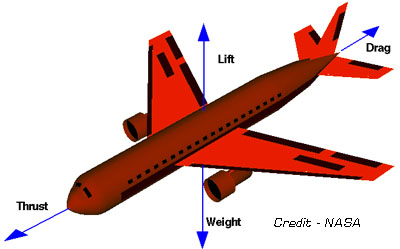
Lift
The factors that determine lift are the shape of the airfoil, the surface area of the wing, the angle of attack, and the speed of the airplane.
Airfoil
A Dutch scientist by the name of Daniel Bernoulli (1700 – 1782) discovered that as the speed of a fluid increases, its pressure also decreases. This same principle applies for airflow over an airplane wing. This is known as the Bernoulli’s Principal.
Have you ever been cruising down the expressway with the windows down and all the sudden a loose plastic bag or piece of paper gets sucked out of the window? Ya? You litter bug!
Since the air moving past the window is moving faster relative to the air inside the car, its pressure is much lower than the pressure inside the car. For this reason the bag is pulled to the low pressure and out the window it goes!
What’s this have to do with how airplanes fly?
Take a look at the cross section view of this airplane wing below. This cross section is referred to as an airfoil. When the air hits the leading edge (front of the wing), some of the air goes over the top of the wing and some of the air goes under the wing.
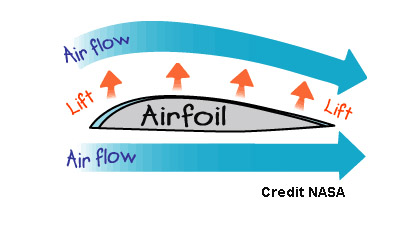
As I’m sure you’re well aware, the shortest distance between any two points is a straight line.
Take a close looks at the airfoil. You can see that the air going under the wing travels a shorter distance before it gets to the trailing edge (the back of the wing). The air going over the wing travels a longer distance before it makes it to the trailing edge.
Both the air going over the wing and the air going under the wing go from the leading edge to the trailing edge in the exact same amount of time. The only way this is possible is if the air going over the wing is going faster than the air going under the wing.
When this happens, the air pressure on top of the wing becomes less than the air pressure on the bottom of the wing. Since force = pressure x area we have more force pushing up on the wing than we have force pushing down on the wing. As a result, we have lift!
As you can see, the airplane wing design is critical for obtaining the flight characteristics that you are looking for.
The faster the air is moving, the greater the pressure difference will be, and the more lift the wing will produce. This is why the speed of the aircraft is so critical.
If this theory describes how airplanes fly, are you wondering how airplanes fly upside down?
The shape of a wing’s airfoil is a key factor that determines how much lift the wing will produce. It has a great impact on how airplanes fly. However, the shape of the airfoil is only one factor that determines lift.
Angle of Attack
The second factor that determines lift is the angle of attack. This is the angle that the wing is tilted upward relative to the flight path of the airplane.
When the front of the wing is raised up, it deflects the air passing by downward. According to Newton’s third law, the air must in turn be pushing the wing up. This is lift!
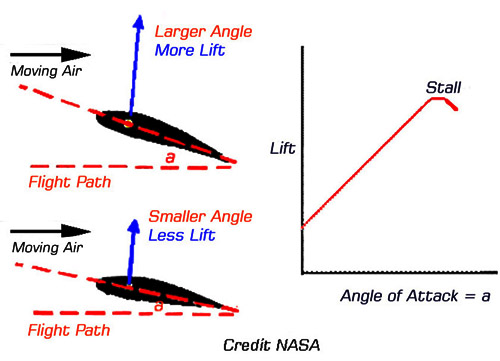
Take a look at the graph above. As the angle of attack increases, so does lift. But when the angle of attack gets too large, the airplane will stall.
A stall means that the airplane is no longer flying, it is falling! This can be very bad in certain situations!
Weight
Weight is a force that pulls the airplane straight down. The weight is actually distributed throughout the entire airplane. However, the weight can be thought of as a single force acting on the center of gravity. The center of gravity is the point at which the airplane balances both laterally and longitudinally. When the airplane is in flight it actually rotates on all three axes about its center of gravity.
Drag
When the airplane is flying, it encounters air resistance. This air resistance is called drag. Drag can be thought of as a force pulling the airplane’s tail backwards. The shape of the airplane, how fast the plane is moving, and the surface texture all contribute to the magnitude of drag.
Thrust
In order to get airborne, the airplane must be moving fast enough for the air moving over the wings to produce lift. The force moving the airplane forward is called thrust. Think of thrust as a force pulling the airplane towards its flight direction.
Thrust is provided by the propulsion system. This could be a single engine propeller, multiple engine propellers, a turbine(jet) engine, or multiple turbine engines.
Conclusion
Scroll up and take another look at Newton’s first law of motion. Since we are learning how airplanes fly, pay particular attention to the second part of this law.
Pertaining to an airplane, this means that the speed and direction of an airplane will not change unless the forces acting on it are unbalanced.
When the thrust is greater than the drag, the forces acting on the airplane are unbalanced. When this happens, the airplane will begin to accelerate. When the airplane accelerates to a sufficient speed, the airfoil and the angle of attack of the wing will produce more lift than the airplane weighs. When the force of lift is greater than the force of weight the airplane begins to fly!
Now you know how airplanes fly!
Similar pages
The Wright Brothers Plane
By unleashing the Magic of Aviation, the Wright Brothers plane has earned a very special place in the heart of all aviation enthusiasts.
It’s hard to believe how far aviation has advanced since that historic day in 1903 at Kitty Hawk North Carolina. By proving to the world that controlled manned-flight was possible, the magic of aviation was unleashed with a vengeance!
This magic quickly ushered in the vintage aircraft of the World War One era followed by the powerful warbirds that changed the course of history in World War Two. Less than 50 years after the first flight of the Wright Brother’s Plane, Chuck Yeager broke the sound barrier in 1947. A mere 22 years after that, Neil Armstrong and Buzz Aldrin were walking on the moon!
Orville and Wilbur were definitely the type to think “outside of the box”. But do you really think they’d believe that we now have robots cruising around on the surface of Mars sending back real-time images? Not a chance…
Orville and Wilbur
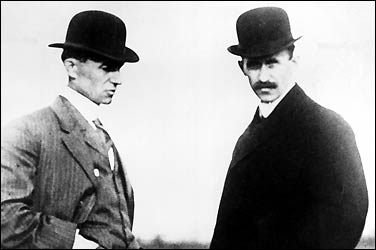 |
Orville and Wilbur became interested in aviation at a very young age when their father bought them a rubber powered toy that resembled a helicopter.
| This helicopter-like toy was designed by a French aeronautical pioneer by the name of Alphonse Pénaud back in 1878.The Wright Brothers called it that “bat”.
Amazingly enough, this very same toy is still available today! |
The Wright Brothers began their adult careers very early on, without even obtaining high school diplomas, by designing and building their own printing press for their weekly publication of West Side News published in their hometown of Dayton Ohio. They opened their very own bicycle shop a few years later. The Wright Brothers interest of aviation never faded since playing with that little toy from their father.
Around the turn of the century there was fierce competition to see who could build the first “flying machine”. Believe it or not, the Wright Brothers’ plane wasn’t the first contraption to fly. Samuel Langley flew an unmanned steam-powered aircraft back in 1896. But what good is an aircraft that flies off a ramp and drops into the Potomac River like a rock!
Earlier aviators such as Otto Lilienthal and Percy Pilcher built and flew gliders in their pursuit of manned-flight. Both of these gentlemen lost their lives to out of control gliders. The Wright Brothers learned from these failures and seemed to be the first to truly understand the importance of “controlled flight”.
While other aviators where focusing on aircraft with more power, Orville and Wilbur focused their efforts on how to control an aircraft. They turned to Mother Nature by studying the flight of birds for the solution!
Wing Warping
They studied how birds change the angle of their wings in order to roll to the left or right. They figured that an aircraft could be controlled in the same manner by “wing warping“. After proving this theory or wing warping by attaching control lines to twist the sides of a box-kite while in flight, they decided to build a glider that incorporated wing warping.
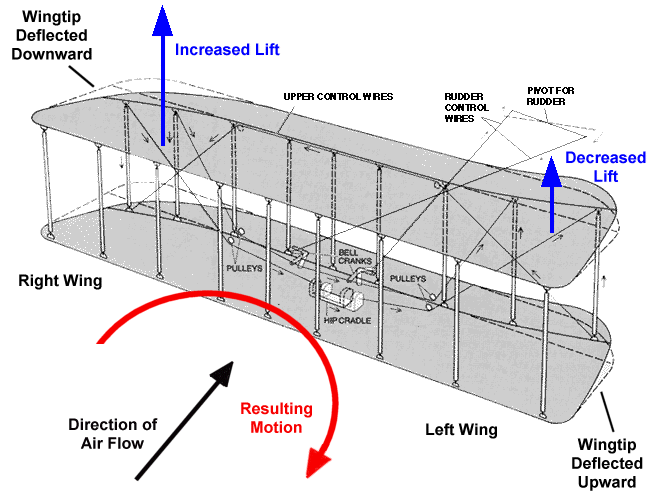 |
| Photo:NASA |
They lift calculations used to design the wings of their fist couple of gliders were based on Lilienthal’s experience with gliders as well as other theoretic data and coefficient that were accepted as fact at the time.
They placed a horizontal control surface, the elevator, in front of the main wings. They didn’t see the need for a rudder at this point.
They chose Kitty Hawk, North Carolina to test their glider because the coastline was windy and the sand provided a good place for hard landings…
When both their first and second gliders produced insufficient lift, they realized the data and theory they used for their design could not possibly be correct.
The wing warping to control roll didn’t exactly work out like they hand planned either. They were the first to discover adverse yaw affect.
The adverse yaw affect is caused by the drag induced at the wing tips of the twisted wings when trying to roll. When the aircraft rolled in one direction, the drag of the opposite wing cased it to yaw in the opposite direction. In other words, when they tried to turn right, they would roll right, but the plane would actually turn left!
Wind Tunnel & Rudder
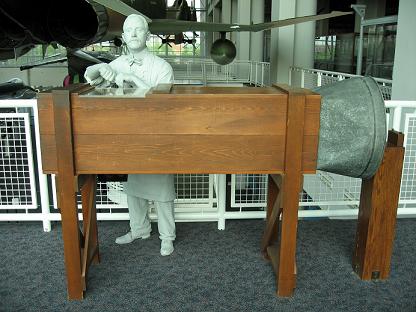 |
| Replica of Wright Brothers’ wind tunnel at the Virginia Air & Space Museum |
Their first couple of gliders were discouraging, but the Wright Brothers weren’t the type to give up. It was back home and back to the drawing board.
This time they decided to build a wind tunnel to test hundreds of wing shapes and models to make sure their next glider would have the lift they needed. They also added a rear vertical “fixed” rudder to counter act the adverse yaw affect.
The third glider provided the lift they expected but the fixed rudder adaptation didn’t have the affect they intended. The new rudder took care of the adverse yaw effect, unfortunately it made it nearly impossible to recover from a turn. When they would try to roll back to level flight after a turn, the aircraft would roll even more sending the plane spiraling to the ground… Ouch…
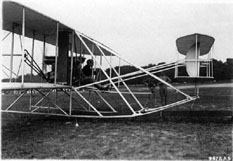
Orville had the perfect solution. A moveable rudder! They used cable to tie the control of the rudder into the control of the wing warping. When the wings were warped to roll, the rudder would automatically deflect in the opposite directly. It worked like a charm!
And there you have it, three axis control of an aircraft! The basis of the Wright Brothers Plane and virtually all present day aircraft!
Only a few years passed after the invention of the Wright Brothers plane before ailerons became the primary method of controlling roll.
There were a few vintage aircraft of the WWI era to use wing warping to roll. But ailerons proved to be more practical and they don’t fatigue the structure of the wing as wing warping does.
Adding Power!
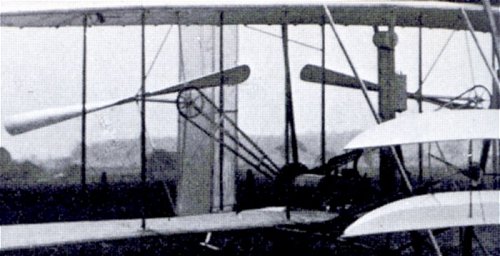 |
After many successful attempts with the glider, it was time to add power to the Wright Brothers plane. You have to keep in mind that propellers were only used to propel boats back in those days. As you know, water behaves a bit differently than air!
Orville and Wilbur first had to come up with a propeller specifically designed to move air. They thought of a propeller as nothing more than a rotating wing, so they used their wind tunnel to help them design the first airplane propellers in history. They were pusher props and were pretty darn efficient too, even by today’s standards!
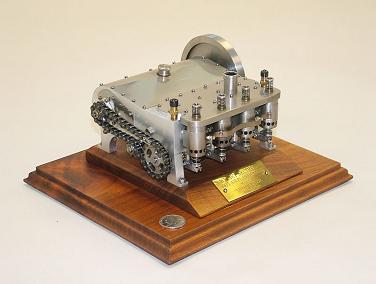 |
They couldn’t find an engine light enough to provide the power they needed. So they turned to their bicycle shop mechanic Charlie Taylor to custom build a lightweight aluminum engine. The engine was connected to the pusher props on each side of the Wright Brothers plane by a heavy duty chain.
The brothers journeyed back to Kitty Hawk and built a set of rails for the plane to roll on to build up speed before lift off. On a cold windy morning on Dec 14, 1903 Wilbur climbed aboard the Wright Brothers plane for that first historical flight that lasted all of 3 seconds before stalling and hitting the ground!
Three days later after minor repairs, Orville gave it a try and kept her in the air for 12 seconds for a total distance of 120 feet. Wilbur and Orville both flew twice that day with Orville’s last flight taking the cake… He managed to fly for 59 seconds for a distance of 852 feet. Now they were getting somewhere!
Unfortunately a gust of wind destroyed the Wright Brothers plane that very same day shortly after Wilbur’s awesome flight…
Refining the Design
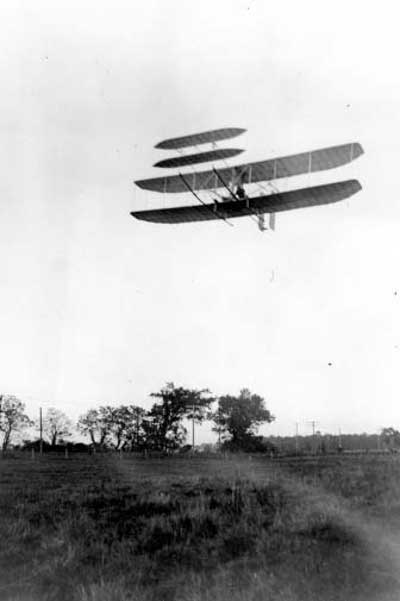 |
| Orville flying the 1905 Wright Brothers Plane |
The brothers build the second Wright Brothers plane the next year in 1904 , this time the decided to fly near their home in Dayton rather than make the trip to North Carolina. A farmer let them use his field just few miles out of Dayton called Huffman Prairie, adjacent to present day Wright-Patterson Air Force Base!
They developed a weighted catapult system and used longer rails to assist in getting the new Wright Brother plane airborne. With tons of practice, persistence, and a lot of rebuilding; the brothers managed to fly a little bit longer and farther as the summer passed. By September of that year Wilbur managed to fly a complete circle!
They built a third Wright Brothers plane to fly the summer of 1905. This time the rudder could be controlled independently from the wing warping. This was the first airplane with true independent control on all three axis. Midway through the summer they made the rudder and elevator control surfaces large and farther away from the wings.
The latest changes made the Wright Brothers plane much more stable which allowed them to stay in the air pretty much as long as they wanted to.
Keeping a Secret
The Wright Brothers were very secretive about their work. They just created the first flying machine for crying out loud, and they didn’t want some Joe Schmoe to steal their idea and get rich from it!
Sure, there were reports of this flying machine of theirs. But most people just thought they were full of it, and the Wright Brothers liked it that way. They refused to fly their plane in public. They only allowed reporters on Huffman Prairie once, under the circumstances that no cameras were allowed. For some odd reason they had engine troubles that day and didn’t put on much of a show…hmmm
They sent letters to United States government trying to sell their aircraft, but the brothers refused to fly the aircraft in order to prove that the Wright Brothers Plane could indeed fly. They were reluctant to even share pictures!
Keep in mind that he U.S. government just paid a “prestigious scholar”, Samuel Langley, a ton of money to demonstrate how his steam-powered aircraft could plummet into the Potomac River. The idea that a couple of bicycle salesman from Ohio without even having high school diplomas could possibly build and fly a “flying machine” was a little far fetched to say the least…
The Wright Brothers were finally issued a patent for their flying machine in May of 1906. However, the brothers refused to fly the Wright Brothers Plane for nearly 2 while they pursued a buyer for the invention.
The Wright Brothers Plane Becomes Famous
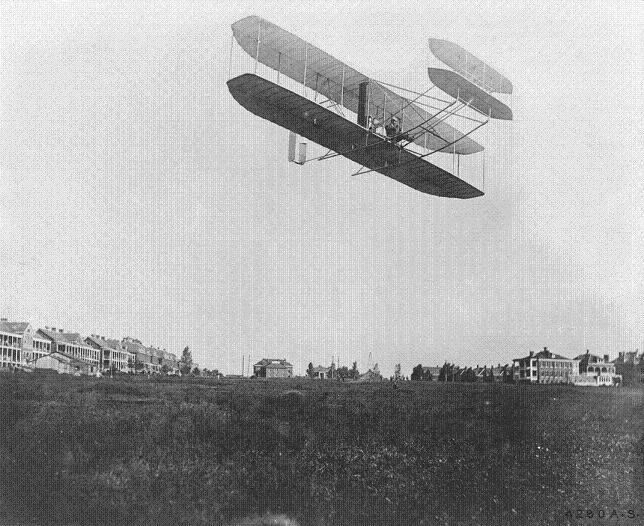 |
| Orville at Fort Meyer demonstration September 1908 |
Finally, in 1908, the Wright brothers signed contracts with both the U.S. Army and French governments which required them to take-off, fly and land their aircraft with a passenger on board.
Equipped with seats and levers for controls, Wilbur made history on Aug 8, 1908 in Le Mans, France by proving to the world that the Wright Brothers plane could really fly. The Wright brothers instantly became known around the world as the brothers from Ohio that created the first flying machine!
Nearly a month later on September 3rd, Orville made his public demonstration to the U.S. Army in Fort Meyer Virginia. A few days later he took a passenger on and hour long joy ride!
How do Airplanes Fly in Specific Directions?
We talked about how airplanes fly. But how do airplanes fly in the specific direction the pilot dictates?
Just as you turn the wheels in your car to change direction, a pilot changes the deflection of the control surfaces to change direction.
Let’s take a look at how this works by examining the fundamentals of airplane aerodynamics.
Axes of Rotation
The center of gravity is the point at which the airplane balances both laterally and longitudinally. When the airplane is in flight it rotates around this point. To fly an airplane we must control this rotation in all three dimensions.
We can define three axes that go through the center of gravity. Each axis is perpendicular (90 degrees) to each other. This will allow us to define the orientation of the airplane by the amount of rotation it has around each of these axes.
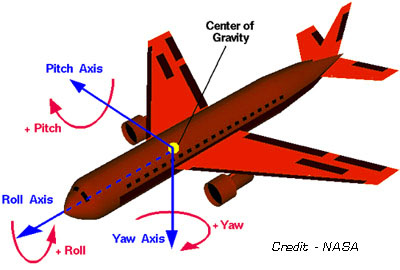
The three principal axes are pitch, yaw, and roll.
The pitch axis is perpendicular (90 degrees) to the yaw axis and is parallel to the wings. This axis starts at the center of gravity and points towards the right wing tip. A pitch motion is when the nose of the airplane moves up or down.
The yaw axis is perpendicular (90 degrees) to the wings of the airplane. This axis starts at the center of gravity and points straight down. A yaw motion is when the nose of the airplane moves from side to side.
The roll axis is perpendicular (90 degrees) to the other two axes. This axis starts at the center of gravity and points towards the nose of the airplane. A roll motion is when the airplane’s wings move up or down.
Control Surfaces
Every airplane has a horizontal stabilizer and vertical stabilizer. Think of these like feathers on a dart. These are what keep the airplane stable in flight. The horizontal stabilizer keeps the airplane’s nose from moving up or down. The vertical stabilizer keeps the airplane from moving side to side.
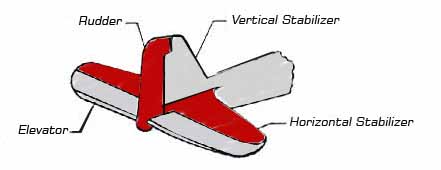
Control surfaces are movable airfoils used to control the movement of the airplane. The three control surfaces that control the airplane’s rotation around each principal axis are elevator, rudder, and ailerons.
We learned that the lift produced by an airplane’s wings is determined by the shape of the airfoil, the angle of attack, and the speed of the airplane. The same is true for the forces generated by each control surface on the airplane.
Elevator
How do airplanes fly up or down?
The elevator is a hinged extension of the horizontal stabilizer. Raising the elevator up or down changes the over all shape of the horizontal stabilizer’s airfoil. When the elevator is raised the air going under the horizontal stabilizer has to travel farther than the air going over it. According to Bernoulli Principal this will decrease the pressure under the stabilizer causing it to be pulled downward.
Remember Newton’s third law? When the elevator swings upwards it deflects the air that is moving past the airplane upward. This means the air is in turn deflecting the elevator downward.
OK, so we have an airplane that is balanced perfectly on its center of gravity which is always located at some point on the wings. The elevator raises up which generates a force that is pushes the tail down.
The airplane pivots on the center of gravity right? Then pushing the tail of the airplane down will make the nose of the airplane rise. In other words, the elevator controls the pitch of the airplane. When the elevator raises the nose of the airplane raises. When the elevator is lowered the nose of the airplane lowers.
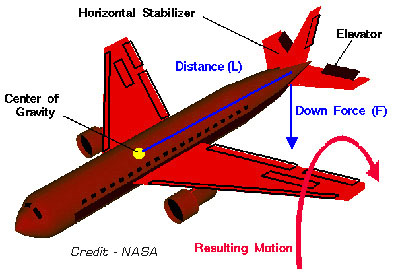
If the nose of the airplane rises, the angle of attack increases. If the angle of attack increases then the lift produced by the wings increases. So by raising the elevator the airplane will gain more lift and start to climb. If the elevator is raised far enough and held in that position long enough then the airplane will do a loop. That is, if the airplane is designed to do a loop. Try that with a jet liner and you may have some issues!
Conversely if the elevator is lowered the nose will lower. That will cause the angle of attack to decrease, and the airplane will descend.
Rudder
How do airplanes fly left of right?
The rudder is a hinged extension of the vertical stabilizer. The rudder acts exactly as the elevator does except it controls the yaw of the airplane. When the rudder swings to the right it generates an aerodynamic force pushing the tail to the left. The airplane pivots on the center of gravity causing the nose to swing right. The exact opposite happens when the rudder swings to the right.
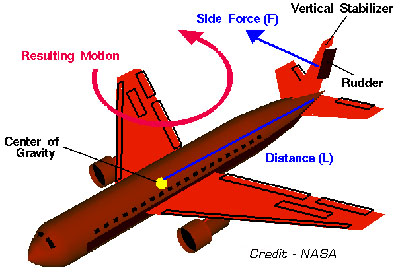
Ailerons
How do airplanes fly in a rolling motion?
Ailerons are control surfaces located on the trailing edge of each wing tip. Ailerons control the roll of the airplane. These are a bit different than the elevator and rudder. It takes two ailerons working opposite of one another to make the airplane rotate around the roll axis. Everything else is the same as elevator and rudder.
When the right aileron raises it changes the overall shape of the wings airfoil and produces an aerodynamic force pushing the right wing down. At the same time the aileron on the left wing lowers and produces a force pushing the left wing up.
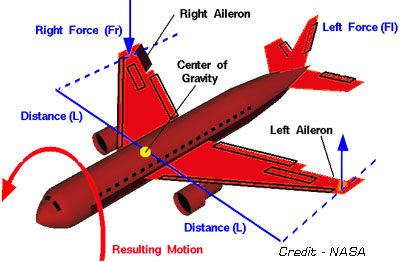
The airplane always rotates about its center of gravity. So we have a force pushing the right wing down and a force pushing the left wing up. This causes the airplane to roll in the clockwise position. This is considered to be “rolling” right. When the right aileron lowers and the left aileron rises the airplane will be “rolling” to the left.
Flaps
How do airplanes fly slower when landing?
Flaps are control surfaces located on the trailing edge of the wing just inside of the ailerons. On an RC airplane they work just like ailerons except the flaps on each wing work together in the down positions. Flaps never hinge upwards like ailerons.
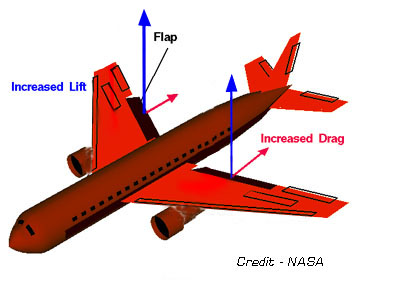
Flaps are used to create more lift at lower speeds when landing. Not only do flaps produce more lift, they also produce drag. This helps slow the airplane down. The flaps will also affect the pitch of the airplane. When flaps are deployed it is necessary for the elevator to compensate for any changes in pitch caused by the flaps.
Summary
To understand how do airplanes fly in the direction you want them to it is critical that you know how to control the rotation of the plane around its principal axes.
The elevator controls the rotation around the pitch axis. The rudder controls the rotation around the yaw axis. The ailerons control the rotation around the roll axis. The flaps produce more lift and drag for landing an airplane.
Recommended Reading
The purpose of this page is to give you a crash course in the basics of how an airplane is controlled. If this is something you’re intresting in learning more about I highly recommend checking out some of the books listed below.
Introduction to Flight (Hardcover) by John David Anderson 7th edition
Fundamentals of Aerodynamics (McGraw-Hill Series in Aeronautical and Aerospace Engineering)
Mechanics of Flight (Hardcover)by Warren F. Phillips
http://www.uread.com/book/mechanics-flight-warren-f-phillips/9780471334583
The Simple Science of Flight (Hardcover)by Henk Tennekes
Understanding Flight, Second Edition (Paperback)by David F. Anderson, Scott Eberhardt
The authors explanations are over simplified and often incorrect. The authors appear to be interested in offering an explanation that sounds plausible, with some technical lingo that might get past a group of pilots, but would raise the eyebrows or a trained engineer. If you want to be able to sound like you know something when talking to non-engineers, then get this book. Be careful to keep quiet though when in the company of those with some real understanding of the physics of flight.
Theory of Flight (Paperback)by Richard von Mises (Author), Kurt H. Hohenemser (Introduction)
I picked up this book for my Aerodynamics course and I love it. Concepts are explained fully and are presented such that they are easy to understand. Plus it’s a Dover book, all of which I’m pretty much in love with.
The Simple Science of Flight: From Insects to Jumbo Jets by Henk Tennekes
Model Aircraft Aerodynamics (Paperback)by Martin Simons
Basic Wing and Airfoil Theory [Paperback]Alan Pope
 Follow
Follow